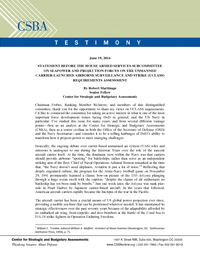
In this testimony delivered before the House Armed Services Subcommittee on Seapower and Projection Forces on July 16, 2014, Robert Martinage challenges the dominant view on the core mission of UCLASS that drive the system requirements.
Martinage argues that the most pressing problem UCLASS must address is maintaining the Navy’s ability to project power from the sea when: 1) carriers are compelled to standoff at considerable distance (e.g., 1,000-plus miles) from an adversary’s territory due to emerging anti-access/area-denial (A2/AD) threats such as long-range anti-ship cruise missiles (ASCMs) and anti-ship ballistic missiles (ASBMs); and 2) it is necessary to find and destroy fixed and mobile/relocatable targets defended by modern integrated air defenses (IADS).
He calls on the Navy to preserve the aircraft carrier’s strategic relevance over the next several decades by developing and fielding a carrier-based UAS with:
- Ultra-long refueled mission endurance to respond rapidly to future contingencies and sustain persistent surveillance-strike operations from carriers positioned outside of A2/AD threat range;
- Survivability sufficient to find and engage, with onboard sensors and weapons, fixed and mobile/relocatable targets defended by modern air defenses;
- Unrefueled combat radius sufficient to range the depth and breadth of the battle space from tankers standing off outside of enemy surface-to-air missile and fighter coverage; and
- As much payload carriage and flexibility as possible to neutralize adversary targets rapidly, minimize the need to return to the carrier to rearm, and hold at risk as many classes of targets as possible.



























